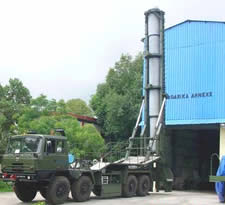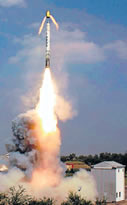  |
| Mystery missile: widely reported as a future sea-launched ballistic missile, is the Shourya launch in November 2008 (right) a land-based mobile missile (left), a silo-based missile, or a hybrid? Images: DRDO |
.
By Hans M. Kristensen
A decade after India officially crossed the nuclear threshold and announced its intention to develop a Triad of nuclear forces based on land-, air-, and sea-based weapon systems, its operational force primarily consists of gravity bombs delivered by fighter jets. Short of the short-range Prithvi, longer-range Agni ballistic missiles have been hampered by technical problems limiting their full operational status [Update Feb. 2, 2009: “Defense sources” quoted by Times of India appear to confirm that the Agni missiles are not yet fully operational]. A true sea-based deterrent capability is still many years away.
Despite these constraints, indications are that India’s nuclear capabilities may evolve significantly in the next decade as Agni II and Agni III become operational, the long-delayed ATV nuclear-powered ballistic missile submarine is delivered, and warhead production continues for these and other new systems.
Our latest estimate of India’s nuclear forces is available from the Bulletin of the Atomic Scientists.
Nuclear weapons budgeting is like agreeing to buying a house without knowing the sales price, the mortgage rate, or the monthly payment.
The United States Air Force has forward deployed about one-third of its B-2 stealth bombers to Diego Garcia, or about half the B-2s considered fully operational at any given time.
Over the past year, the campaign to abolish nuclear weapons has experienced numerous wins that were celebrated at the Meeting of State Parties.
China is NOT a nuclear “peer” of the United States, as some contend.
China’s total number of approximately 600 warheads constitutes only a small portion of the United States’ estimated stockpile of 3,700 warheads.